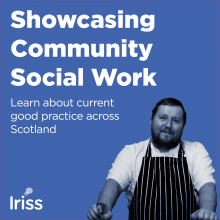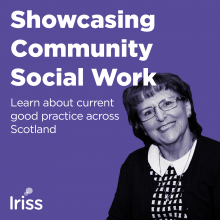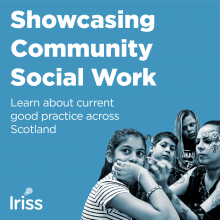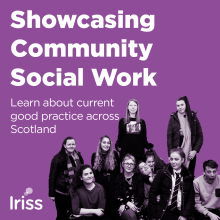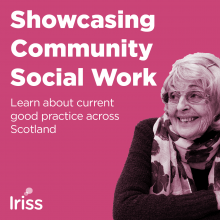Key points
- Community social work challenges the notion that the role of a social worker is to produce assessment and care plans, and gives primacy to work methods based on relationships and partnerships
- It should not be regarded as a peripheral activity, but as a function of, and located within, mainstream frontline social work teams
- Community social work recognises that early-intervention approaches can act to prevent the escalation of social problems, to the point that statutory interventions become inevitable
- As a driver of community development, community social work, involves working together to tackle disadvantage, and networks that include community members and partner agencies
- As a collective activity involving creativity and imagination, community social work is rewarding for practitioners and contributes to worker retention strategies that avoid stress and burn-out
- Community social work is not prescriptive and so, while it can embrace statutory duties of all types, is flexible and adaptive so that a response can be offered in crisis situations; whether within a family, a locality or in response to global catastrophe
- Community social work is based on interventions determined through bottom-up rather than top-down initiatives, supported by enabling senior managers, based on local practice knowledge, understanding of strengths and weaknesses, and in partnership with communities
Introduction
Social work practice in Scotland remains largely driven by the defensive and neo-liberal practices that arose out of the NHS and Community Care Act 1990, and the Children (Scotland) Act 1995. Defensive because they placed emphasis in practice on individualised risk assessment in response to implied criticisms of the profession; neo-liberal because they introduced the business notions of cost-effectiveness and the marketplace as drivers of good practice, determining conceptualisations of quality and effectiveness (Lymbery, 2001; Lymbery and Postle, 2010). Faced with drastically reducing budgets after the bank crash of 2008, councils responsible for services were forced to make cuts that have reduced scope and rendered risk-aversion the principal driver (Harris, 2003; Harris and White, 2009; Turbett, 2014; Rogowski, 2020).
One of the unintended but perhaps inevitable consequences of the 1990s legislative changes was the creation of ever more specialist teams that would address questions of competency and expertise in particular areas of practice. This has resulted in a silo-mentality within social work, with a centralisation of separately managed services, and border issues about who should deal with what and for how long. Bramley and colleagues (2019) powerfully describe the impact of this on individuals with substance misuse issues. Another commonly experienced example is of children and family social workers not being seen as interested in the particular problems of the parent (Adebowale, 2014). Such fragmented services lead to sometimes rather bureaucratic constructs such as ‘transition planning’ (people moving from children to adult services due to disability or other needs) and to ‘signposting’ being used inappropriately as a mechanism to avoid responsibility and ownership. The problem of burgeoning workloads within local authority social work is pressing: recent surveys have shown that staff are at breaking point and that worker retention is an issue in many frontline teams (Ravalier and Boichat, 2018; Community Care, 2019; UNISON Scotland, 2019).
The generic practice that enabled – even if it did not always deliver – flexible, seamless responses prior to the 1990s, now seems to be history. The notion of ‘community’, often central to social work courses until the abolition of CCETSW (Central Council for Education and Training in Social Work) in 2001 (Turbett, 2018), has been sidelined, and professional competence is often judged on familiarisation with risk assessment procedures and fast turnaround of statutory assessments. Prevention and community capacity is mentioned in Changing lives: report of the 21st century social work review (Scottish Government, 2006) as part of the social work role. However, it is identified as the lowest priority (Tier 1). Highest priority is given to complex (and over burdening caseloads) at Tier 4.
However, outside the increasingly narrowing parameters of social work, changes have taken place in Scotland in the general framework surrounding service delivery. The notion of community has become embedded in legislation. The Public Bodies (Joint Working) (Scotland) Act 2014 and Community Empowerment (Scotland) Act 2015, set out imperatives to work directly with communities, to ensure services meet the needs of people who use them. The former requires service users, carers, and organisations which provide services, including the third sector, to be involved in the strategic planning and commissioning process locally. The latter requires communities to be involved in shaping locality plans, ‘strengthening their voices in decisions about public services’ with a key focus on tackling inequalities.
The Social Care (Self-directed Support) (Scotland) Act 2013 (SDS) also emphasises the building of ‘vibrant communities’, requiring local groups and networks to replace traditional (and costlier) services with user-led and informed ones for disabled people and their carers. The statutory principles of SDS underpinning this legislation list: participation and dignity, involvement, informed choice, and collaboration – all components of community social work (CSW) approaches1. Some authorities have prioritised community capacity building in their approach to SDS, and seed funding has been provided to support this (Scottish Government, 2018). Other associated policy drivers are demonstrated in table 1 (below).
|
Date |
Policy driver |
Key points |
|---|---|---|
|
2011 |
The Christie report: The commission on the future delivery of public services |
A radical redesign of public services was required, with an emphasis on preventative public services that reduce inequalities, and embed community participation in their design and delivery. This would more effectively respond to needs, promote self-reliance and resilience, reduce silo mentality and move towards integration of services. |
|
2013 |
Audit Scotland report: Improving community planning in Scotland |
Reducing social inequality through partnership working in each of Scotland’s 32 local authorities, with a shift towards prevention, improving outcomes and reducing future need. |
|
2016 |
Audit Scotland report: Social work in Scotland |
Building community capacity so that communities can support those at risk of needing to use services; considering examples of innovative practice from across Scotland and beyond. |
|
2017 |
COSLA National health and social care workforce plan (part 1) |
Getting the right people into the right place at the right time, to deliver sustainable and high-quality health and social care services for Scotland’s people. |
While the Public Bodies (Joint Working) Scotland Act 2014 is a crucial legislative driver, bringing health and social care together to drive down hospital discharge rates for older people, it is also a contentious one. New partnership models, now in place throughout the UK, have been critiqued from within the social work profession for their negative impact – healthcare professionals and their managers have a numerically greater presence in partnerships, and arguably dominate them to the diminution of social work’s voice. In Scotland this is reported within children’s services (Stephen and colleagues, 2015; Social Work Scotland and colleagues, 2019) and practice learning (Gordon and colleagues, 2019). In effect, and in contrast to the important place of social work ascribed by the 1968 Act, this has led to assimilation by health dominated systems (Phillipowsky, 2019). This is an important consideration if we are looking for a rebirth of social work’s promise and potential.
Our future also involves consideration of COVID-19, evaluation about how we have dealt with it, might continue to deal with it, and its aftermath. During initial lockdown, the pandemic involved a unity of purpose within communities that could provide an impetus for a ‘new normal’ – a better way of doing things embodied in fairness and justice. COVID-19 has exposed the inequalities within society that saw already disadvantaged groups suffer the most (Blundell and colleagues, 2020; CPAG, 2020; Sanders, 2020). In some places, social work rose to the challenges this created and responded in new ways to continue its service to the most vulnerable during the crisis. Online and telephone peer support services are emerging through research as positive resilience-building factors for individuals with mental health issues coping with the pandemic (Fisher and colleagues, 2020; Fortuna and colleagues, 2020). CSW approaches could have a big part to play in creating a positive ‘new normal’.
Finally it should be remembered that the International Federation of Social Work (IFSW) includes in its definition of social work:
“…social work engages people and structures to address life challenges and enhance wellbeing.”
IFSW 2014
This too points to inclusive approaches fundamental to CSW.
What is community social work?
CSW has a long and perhaps contentious history in Scotland, mirroring its fortunes in the UK. Social work’s origins lie partially in the Settlement Movement of the late 19th Century whose approach was based on seeing individual issues within a community context, albeit some criticised it for ‘remoralising’ the poor. This was interpreted by some radical elements as incorporating collective action against appalling conditions of poverty (Ferguson and Lavalette, 2007). In Scotland, the building of the post-war welfare state in a climate of growing economic prosperity led to developments that resulted in the Social Work (Scotland) Act 1968, within which the concept of community was considered fundamental to tackling social problems. In the 1980s, the Barclay report (1982) suggested a refocus on community and introduced the concept of CSW. While concerned with services in England and Wales, Barclay did have influence in Scotland, being seen by some as carrying forward the commitment of the 1968 Act to ‘promote social welfare’. A number of initiatives resulted, all of which foundered during the Thatcher years of the 1980s and resulted in the 1990s legislation and practices discussed in the introduction. A more detailed history of CSW in Scotland is discussed in Turbett (2018).
A 2018 exercise, led by Iriss, showcased examples of CSW in Scotland, illustrating their positive impact (Iriss, 2018). They evidenced how working with and alongside excluded communities and relevant agencies supported a preventative approach, generating new capacity, such as knowledge, skills, resilience and wellbeing, and increased peer support, community agency, leadership and influence. This included shaping and improving services. Three initiatives were located within mainstream statutory social work: two from the Glasgow Govanhill based Asylum and Roma Team (ART) with enthusiastic social workers led by an enlightened local manager; and another, established by East Lothian Council social work and Who Cares? Scotland.
Contributions from an Orkney social worker, Gillian Ritch, to Iriss’s Rural Social Work Blog (2020), also suggested that community focused social work responses were emerging out of the placement of social work staff in the main community hub for the islands during the COVID-19 crisis (Iriss, 2020). The writer experienced a similar and almost spontaneous community response involving frontline social work staff in a winter emergency on the Isle of Arran in 2013 (Turbett, 2014). This notion of responses emerging from particular community circumstances is central to CSW – while this might seem to rule out a prescriptive outline of the methods used, there are features from the literature that underpin community social work approaches (table 2).
|
Traditional |
Community social work |
Changes required |
|---|---|---|
|
Reactive: service provided when the situation has deteriorated and the user’s networks are unable to cope. |
Preventative/pro-active: social work intervenes before a service is referred for statutory intervention. |
|
|
Services at arm’s length: services compartmentalised through institutional and bureaucratic procedures and remote location – monopolised by overwhelming demands of individuals within a community. |
Services close to community: Social work practice determined by the living conditions, environmental and social situations of community members. |
|
|
Professional responsibility: practitioner is entirely responsible for solutions to user’s problems. |
Shared responsibility: solutions and responses mutually agreed and shared. |
|
|
Centred on individual service-user: the individual is the only target of intervention. Assessment is based on their internal problems and the degree of pathology. |
Centred on social network: the target of intervention is the social network, including the person seeking a service. Assessment centres on the distribution of responsibility and capacities to adapt. |
|
Underlying most referrals are factors of disadvantage arising from poverty, discrimination and inequality. Attention to these at an earlier stage can prevent the cycle of decline that leads to drug and alcohol misuse and poor mental health that feature in so many children and family, child protection, youth and criminal justice referrals (BASW, 2019). As Smale and colleagues (2000) suggest, if we can prevent people from falling into the river in the first place, we will not have to intervene to stop them drowning later on. The early intervention principle applies to the support of those who are disadvantaged by disability and ageing based on the social model of disability: barriers to inclusion and opportunity come from society, not from the individual to whom such difference or impairment applies (Oliver and colleagues, 2012).
Mainstreaming community social work
In relation to children and family interventions, the Bywaters-led research team have examined data relating to looked-after children and regional differences across the four jurisdictions of the United Kingdom. In Northern Ireland, 75% fewer children were placed in foster and adoptive care placements than in Scotland (Bywaters and colleagues, 2020). There are strong suggestions that Northern Ireland’s figures might reflect more community orientated approaches to work with families (Das and colleagues, 2015). CSW is specifically mentioned as part of the overall anti-poverty framework for social workers by the Northern Ireland Department of Health (Department of Health NI, 2018). ‘Family support hubs’ are universal, although their nature differs from area to area: these provide co-ordinated non-statutory support from both health (which includes social work) and third sector organisations, and can be the physical base of ‘Gateway’ services (the first point of contact for those seeking or referred for formal social work supports). The Gateways operate on a step up/step down basis so that families and children can be referred on for a statutory service, but also referred back if that becomes unnecessary; a need for less formal support has been identified. Such developments are not unique to Northern Ireland. The Frome medical study (Abel and colleagues, 2018) demonstrated how community development approaches reduced admissions to acute care by 14%. In Northern Ireland, social workers in primary care multi-disciplinary teams are also strongly encouraged to undertake an Ulster University postgraduate programme known as Social Work and Community Development Approaches, introduced in 2018. There is no postgraduate qualification on this in Scotland, and McPheat and colleagues (2017, p10) study identified that ‘community development and engagement did not feature as a significant factor in current social work education.’
The Scottish Government’s most recent policy publication for children and family social work activity (Scottish Government, 2015) suggests a narrower focus for statutory interventions in respect of vulnerable children. It discusses a framework for ‘early engagement’ with support services typically being provided by commissioned third sector organisations for children ‘on the edge of care’ (ibid, p12), and ‘early permanence’ i.e. planning services to ensure that children are subject to ‘stable, secure, nurturing relationship and home, where possible in a family setting that continues into adulthood’ (ibid p,18). The guidance expects ‘…local authorities to presume against looked after at home status when planning interventions and when making recommendations to managers, Children’s Hearings and courts, except where at home status is an essential part of a clear plan to remedy a short-term issue or towards permanence.’ (ibid, p17). Otherwise children should be considered for out-of-home care in an alternative placement. All this, the strategy suggests, can result in better outcomes for children at a reduced cost to the public purse.
Statistics, however, indicate that Scotland has the highest number of looked-after and accommodated children of all four jurisdictions. Using relative indicators of poverty and deprivation when compared to Northern Ireland, it should have 60% less than it actually has (Bywaters, 2020). It is important to note, however, that this figure may not properly reflect the impact of widespread use of kinship care, and the impact of the Children’s Hearing System. Linked with this, research work undertaken by Bilson of Central University Lancashire (Professional Social Work, December 2018) reported practices in Scotland in relation to child protection (CP) investigation that contained disproportionate local variations. It suggested an unnecessary emphasis on the possible removal of children from their families: two neighbouring authorities in Central Scotland, with similar demographics, had an 11% variation in CP investigations of under four year olds. Bilson also contends that authorities with the largest numbers of children placed for adoption also have the highest number of children in the care system. He contends that different approaches, including parent self-advocacy, can bring about remarkable changes without keeping children in situations of risk. Emphasis, he argues, should be placed on building social capital in marginalised communities rather than on abuse and its prevention (Bilson and Munro, 2019). This absolutely fits with the premise of CSW.
CSW is compatible with notions of family support that are at the heart of preventative approaches to children and family social work. A central question is whether they should be conducted as a component of mainstream or frontline statutory social work? The answer from a CSW perspective is a resounding ‘yes’, with relationship-based social work within single multi-disciplinary teams, rather than a tiered approach where referrals are made from one team to another with inevitable delays, tensions and loss of trust. This makes good use of the investment in training and the motivation of most social workers – the suggestion implicit in the Scottish Government 2015 strategy that their role should be focused on ‘permanence’ planning will be seen by many as a reduction of the children and family social work task to a very downstream and implicitly oppressive role.
Building a community social work approach
Social workers generally take it for granted that community is an important concept in their assessment of an individual’s circumstances, the disadvantages they encounter, and their capacity for change (integral to Scotland’s GIRFEC approach). CSW takes this a step further by looking at how commonalities might determine social work responses. This will necessarily entail a more detailed understanding of the locality or community in which staff work, than might be the case with traditional approaches. It is probably worth defining in broad terms what we mean by ‘community’. In many cases it might be a geographically defined locality, but could be a particular group within a locality (Popple, 2015). Such definitions really depend on self-identity – ethnic group, religious group, or other commonalities – and individuals may belong to overlapping or multiple communities. The literature tends to refer to ‘communities of locality’ and ‘communities of interest’ (Hadley and colleagues, 1987). Communities of course are not necessarily supportive environments – they can be oppressive, especially to minorities within them, or with whom they intersect. Social work already has an anti-racist heritage, and CSW has the potential to address important issues of discrimination raised by the Black Lives Matter movement that re-emerged in the summer of 2020 (Pierson, 2008; Black Lives Matter, 2020).
CSW borrows from the basic skills and strategies of community work (eg as covered in Henderson and Thomas, 2001) and in Community Development National Occupational Standards (2015). A start should involve an attempt by service providers at local or team level to understand their communities. Community profiling (mapping) (Henderson and Thomas, 2001; Hawtin and Percy-Smith, 2007) is a useful tool, helping analyse strengths and weaknesses. Data gathering can also usefully inform practice, policy and resource deployment – another useful function of CSW. Furthermore, community mapping can tap into ‘practice wisdom’ – the conscious or unconscious knowledge social workers use to make decisions (Harris and White, 2018; Samson, 2014). This process should identify key actors – local activists as well as personnel from other agencies. The identification of strengths (resilience factors) is as important as the identification of common problems: the purpose of the exercise is to address risk factors through upstream or early intervention strategies to head off eventual statutory referral (Smale and colleagues, 2000). The theory and practice of ‘community asset building’ (Russell, 2020) is useful here in its focus on facilitating leadership by community members themselves. Much might be learned from the experience of the community hubs and other support activities and networks that emerged during COVID-19 – this should all be included. Team members should make an effort to become involved in local networks and use them as an opportunity to discuss CSW approaches and win support and wider involvement.
While an emphasis is on preventative and often collective strategies, alternative ways of working with statutory cases can be incorporated into CSW approaches. Hardcastle (2011, pp402-18) discusses ‘community social casework’ as an allied method, and this idea can be seen in some current practice in Scotland: the Assessment Framework used for children (including the GIRFEC ‘My World Triangle’), and some models of community care assessment for adults. CSW takes these further to plan interventions and not just assess risk. With imagination and creativity, bottom-up approaches based on collective activity can be used to work with individuals subject to statutory interventions. These might involve group activities or linking individuals with existing supportive resources and networks in the community. Creative responses can be especially effective in dealing with factors surrounding the common referral factors of substance and alcohol misuse, and domestic abuse, such as low self-esteem and absence of life coping skills. Domestic abuse, and other concerns like child neglect, are often hidden in plain sight to professionals but known about within communities: CSW approaches are especially suitable for identification and early intervention. Peer group support can be more effective than advice from a worker who is unlikely to have shared the experiences of a service user. Particular casework examples include: Family Group Decision Making (Children 1st, nd) which offers a tried and tested early intervention model; Restorative Practice is another involving young people at risk, used successfully in Leeds and to be piloted in Edinburgh (Child Friendly Leeds, nd). Both fit with the idea of community based teams that identify issues and address them at an early stage.
An important aspect of CSW is leadership: the facility to build a service based on locally identified needs in partnership with users, carers and community networks (ie bottom-up initiative), requires support and understanding at political and social work leadership levels. The policy drivers and legislation identified suggest that political support can be won, but permission and facilitation from senior managers in councils and Health and Social Care Partnerships depends on their understanding of CSW, as well as the commitment of passionate frontline managers. The history of the 1980s growth and decline of CSW suggests that these are essential if new ways of working are to be sustained beyond the initial enthusiasm of pioneering staff groups and community activists (Hadley and colleagues, 1987; Smale and Bennett, 1989).
One of the questions that will arise through local implementation of CSW is the place of specialist teams within frameworks that are about defragmenting social work. This is a debate beyond the scope of this paper, but given the core elements of relationship-based social work that are at the heart of CSW, practice across boundaries is not impossible and need not risk loss of expertise in particular service areas.
The challenge for the future
CSW offers an opportunity to work in partnership with local communities to build new ways of working that fit with policy and legislative imperatives, and address some of the concerns about social work’s trajectory. This encompasses issues of retention, professional identity and the diminution of social work’s voice in the current landscape.
This Insight condenses the core evidence supporting CSW approaches available. There are some areas that Scottish Government, employers, educators, researchers and the representative and leadership bodies for social work might wish to consider:
- Workforce development – training and guidance – both to prepare frontline staff and facilitate the support and encouragement of senior managers
- Academic interest – more research and evaluation into the impact of CSW approaches
- Undergraduate social work training – the incorporation of CSW into practice model teaching
- Consideration of postgraduate qualifications to enhance practice and existing career pathways
That said, individual practitioners have some responsibility for taking CSW forward, given it aligns to social work values and efforts to tackle social injustice. CSW, as argued in this paper, is a bottom-up approach albeit facilitated by policy, resources, support and encouragement.
Workshop sessions and discussions on CSW in recent years have confirmed for the writer that there is support and enthusiasm. The rest is over to the readers.
References
- Abel J, Kingston H, Scally A et al (2018) Reducing emergency hospital admissions: a population health complex intervention of an enhanced model of primary care and compassionate communities. British Journal of General Practice, 68, 676, e803-e810
- Adebowale, Lord Victor (2014) Social work services must collaborate to improve services. The Guardian.
- Barclay P (1982) Social workers – their role and tasks. London: Bedford Square Press
- BASW (2019) The anti-poverty practice guide for social work.
- Bilson A and Hunter Munro E (2019) Adoption and child protection trends for children aged under five in England: increasing investigations and hidden separation of children from their parents. Children and Youth Services Review, 96, 204-211
- Black Lives Matter UK (2020) Official statement.
- Blundell R, Costa Dias M, Joyce R et al (June 2020) COVID-19 and inequalities. London: Institute for Fiscal Studies and Nuffield Foundation.
- Bramley G, Fitzpatrick S, Wood J et al (2019) Hard edges Scotland: new conversations about severe and multiple disadvantage – summary report. London: Lankelly Chase.
- Brock J and Everingham S (2018) Integrated children’s services in Scotland: practice and leadership. Social Work Scotland, Healthcare Improvement Scotland and Care Inspectorate.
- Bywaters P (2018) Community Care.
- Bywaters P and the Child Welfare Inequalities Project Team (July 2020) The child welfare inequalities project final report – executive summary.
- Child Friendly Leeds (nd) Improving Leeds children’s lives through restorative practice.
- Child Poverty Action Group (2020) Poverty in the pandemic – the impact of Coronavirus on low Income families and children. London: CPAG.
- Children 1st (nd) Family Group Decision Making.
- CLD Standards Council (2015) National occupational standards. Glasgow: CLD.
- Community Care (2019) Half of social workers consider leaving the profession for ‘less stress’, survey finds. Community Care.
- Das C, O’Neill M and Pinkerton J (2018) Re-engaging with community work as a method of practice in social work: a view from Northern Ireland. Journal of Social Work, Vol 18, issue 4
- Department of Health (NI) (2018) Anti poverty framework for social work practice in Northern Ireland. Available at: https://s.iriss.org.uk/34Q7yy3
- Ferguson I and Lavalette M (2007) The social worker as agitator: the radical kernel of British social work. In Lavalette M and Ferguson I (eds). International social work and the radical tradition. Birmingham: Venture Press
- Fisher EB, Miller SM, Evans M et al (2020) COVID-19, stress, trauma, and peer support – observations from the field. Translational Behavioral Medicine, 10, 3, 503-505
- Fortuna KL, Myers AL, Walsh D et al (2020) Strategies to Increase peer support specialists’ capacity to use digital technology in the era of COVID-19: pre-post study. JMIR Mental Health, 7, 7.
- Gordon J, Gracie C, Reid M et al (2019) Post qualifying learning in Scotland – a research study. Dundee: Scottish Social Services Council.
- Hadley R, Cooper M, Dale P et al (1987) A community social worker’s handbook. London: Routledge
- Hardcastle D, Powers P and Wenocur S (2011) Community practice – theories and skills for social workers. Oxford: Oxford University Press
- Harris J (2003) The social work business. London: Routledge
- Harris J and White V (2009) Modernising social work – critical considerations. Bristol: Policy Press
- Harris J and White V (2018) Oxford dictionary of social work and social care. Oxford: Oxford University Press
- Hawtin M and Percy-Smith J (2007) Community profiling – a practical guide. Berkshire: Open University Press
- Henderson P and Thomas D (2001) Skills in neighbourhood work. London: Routledge
- International Federation of Social Work (2014) Global definition of social work.
- Iriss (2018) Showcasing community social work – a series of case studies. Glasgow: Iriss.
- Iriss (2020) Exploring rural social work in Scotland: notes from the field. Glasgow: Iriss.
- Lymbery M (2001) Social work at the crossroad. The British Journal of Social Work, 31, 3, 369–384
- Lymbery M and Postle K (2010) Social work in the context of adult social care in England and the resultant implications for social work education. British Journal of Social Work, 40, 2502-2522
- McPheat G, Stewart A, McIntyre G et al (2017) Review of social work education; area of enquiry 3: to what extent should social work education have a stronger focus on community development and engagement? Glasgow: University of Strathclyde
- Oliver M, Sapey P, Thomas P (2012) Social work with disabled people. 4th edition. Basingstoke: Palgrave Macmillan
- Phillipowsky D (2019) Is this integration or assimilation? Professional Social Work Magazine, April edition.
- Pierson J (2008) Going local – working in communities and neighbourhoods. Abingdon: Routledge
- Popple K (2015) Analysing community work – theory and practice. 2nd edition. Maidenhead: Oxford University Press
- Ravalier J M and Boichat C (2018) UK social workers: working conditions and wellbeing. Available at: https://s.iriss.org.uk/386tirr
- Rogowski S (2020) Professional social work – the rise and fall of a profession? 2nd edition. Bristol: Policy Press
- Russell C (2020) Rekindling democracy – a professional’s guide to working in citizen space. Oregon: Cascade Books
- Samson P (2014) Practice wisdom: the art and science of social work. Journal of Social Work Practice, 29, 2, 119-131
- Sanders R (2020) COVID-19, low incomes and poverty. Glasgow: Iriss.
- Scottish Government (2006) Changing lives: report of the 21st century social work review
- Scottish Government (2015) Getting It right for looked after children and young people. Edinburgh: Scottish Government.
- Scottish Government (2018) Transforming social care: Scotland’s progress towards implementing self – directed support 2011-2018. Edinburgh: Scottish Government.
- Smale G and Bennett W (1989) Pictures of practice: Vol.1 – Community social work in Scotland. London: NISW
- Smale G, Tuson G and Statham D (2000) Social work and social problems – working towards social inclusion and social change. Basingstoke: Macmillan
- Stephen J, Lerpiniere J, Young E et al (2015) Integrating health and social care in Scotland: potential impact on children’s services. Celcis, Children in Scotland, Social Work Scotland.
- Turbett C (2014) Doing radical social work. Basingstoke: Palgrave
- Turbett C (2018) Community social work in Scotland – a critical history. Iriss, SASW and Social Work Scotland
- UNISON Scotland (2019) Save from harm – UNISON Scotland survey of social work teams.
Acknowledgements
This Insight was reviewed by Helen Allbutt (NHS Education Scotland), Jude Currie (Scottish Association of Social Work), Claire McCartan (Queen’s University Belfast), Lindsay McLaughlin (North Ayrshire Council), Keith Moore-Milne (Asylum and Roma Children and Families Team, Govanhill), Neil Quinn (University of Strathclyde), Fergal O’Brien (Southern Health and Social Care Trust Social Services, Workforce Development and Training Team) and colleagues from Scottish Government. Comments represent the views of reviewers and do not necessarily represent those of their organisations. Iriss would like to thank the reviewers for taking the time to reflect and comment on this publication.
The author gives special thanks to all the peer reviewers who provided very helpful comments, suggestions and references to enhance this paper and to Kerry Musselbrook for editorial support.
1 The additional principles of innovation, responsibility and risk enablement have also been added to reflect the opportunity for creative and flexible approaches to care and support.

